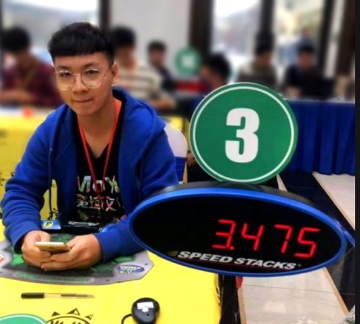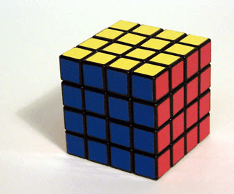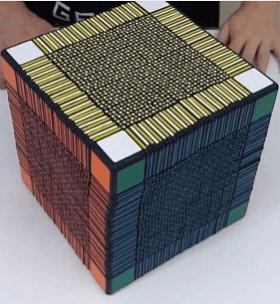The title—what's
with that? It's the total number of possible combinations for a Rubik's
cube. A 3x3 cube with six different colors.
If you are like me, you feel good if you can solve one, and occasionally two,
sides of this world-famous puzzle.
There have been
many scientific papers written on the Rubik's cube—maybe because it is one of
the most widely-known "toys" in the world. According to my highly expert
internet research, over 350 million Rubik's cubes have sold since they first
appeared in Budapest around 1970. How's that for entrepreneurship in a
communist country? I know McDonald's talks about its billions sold, but 350
million plastic mind-tormentors? Wow.
Take another
look at the number that is my title: it's 20 digits long and over 40
quintillion (I got that from, you guessed it, the internet). Bigger than the national
debt (for now). But I learned about a different named number during my research
into this diabolical puzzle—a number colloquially called "God's Number" among
cube enthusiasts. This is the proven minimum number of moves it takes to solve any
Rubik's cube starting point, and it took mathematicians over thirty years to
crack it, and declare that it's 20. Think about that for a second: Any Rubik's
cube starting position can be solved in 20 moves. We can move from a position
that is 1/43,252,003,274,489,856,000 to a solution in no more than 20 iterations!
The number's name comes from the notion that only a mind vastly more powerful
than a human's could look at a cube and know the solution.
I reached out
to my firm's analytics team to ask if we could develop some kind of AI that
powerful. To my disappointment—or maybe relief—Eric Brown told me "not a
chance." But then he offered an observation even more useful:
"There are world record holders in solving these things—and they
don't have God's mind. They don't see all gazillion combos and pick the right
one. They use a methodology that takes work to learn, and brains and effort to
execute. But some folks who have subjected themselves to this discipline can do
amazing things."
First, I got Eric to admit that he has never been patient enough to complete even one side of a Rubik's cube. Then I looked into these record holders.

This is Yusheng Du. In 2018, he set the current record for solving a cube at a brisk 3.47 seconds. I'm sure he's very smart but more importantly, he learned a skill, albeit a very complex one, and employed that skill with excellence.
My son has
gotten his Rubik's cube skill down to the point that he can usually solve one
in about 45 seconds. As I said, I'm still lucky to complete a single side.
Ok, time for my
world-famous pivot (see what I did there?) where I connect this to the world of
community banking.
The key to the
(standard 3x3) Rubik's cube is that the middle square on each face cannot move
and does not change. Think about that for a minute. The middle is fixed in
place. That sounds to me like banking for the longest time, maybe the entire twentieth
century. For decades, the fundamentals never really changed much. The center
held. We could pay 2% on our deposits, lending out at 6%, and be on the golf
course by 4:00 in the afternoon.
My son is Gen Z, and he's decided that the plain old 3x3 Rubik's cube is too simple. He can solve it now, basically without thinking, just by applying a well-learned method of certain moves. So, he has moved on to the 4x4 cube, called the Rubik's Master Cube.

This is a totally different game! Now the center CAN
change. The four squares in the middle of each face need to be established before
moving on to the rest of the solution. Nothing is fixed. So he has had to put
in the work—learning from video teachers, studying his notes, practicing his
moves—to learn to work this puzzle. He can now usually finish the Rubik's
Master Cube in about an hour. It is no longer too simple.
This is what banking
looks like today: no longer simple.
In fact, maybe
banking is becoming more like the 5x5 Rubik's Professor's Cube. Believe it or
not, the record for the 5x5 cube is still less than a minute. However, the
patterns, techniques, and methodology that the solvers must go through are much more difficult. The competitors at
this level have special, lubricated, and well-worn cubes they use because
physical dexterity and choreography are a part of doing it that fast.
Check out Feliks
Zemdegs setting the world record on the Professor Cube in 2017. It takes him 38.52
seconds. Watch the video here.
Back to the banking problem. We have entered a new era of
banking where our "center" has moved. Our
industry is no longer in a "3x3" world.
I'm not saying banking was easy the past several years, just as for
someone like me, even a 3x3 Rubik's isn't close to being easy. Plenty of folks
have had difficulty putting all the parts of excellent banking together even in
easier times. But many learned the methods and eventually put all "6 sides" of
their puzzle into place.
But that has changed, almost certainly forever. The center
is no longer fixed.
Now, we can all pretend that we still live in a 3x3 world,
at least until Chase, Bank of America, and Wells Fargo take over everything, or
we can learn to become more like Feliks mastering the 5x5 in 38.52 seconds.
It's a stark reality. We need to get better, faster, and smarter. Ignoring
technological advances is just simply not an option. Even if we don't think the
big money center banks can ever completely take over, we still have to contend
with the fintechs jumping up around every corner.
My son the Gen-Z-er, has also opened a Robinhood account to
trade partial shares of the stocks he likes, including Adobe, Amazon, and Apple.
You recognize all the names. He's not alone. All of his friends are doing this,
too. They all trade and they compare their performance. Admittedly, the dollar
amounts are small, but they want to play the game. I imagine they aren't
particularly interested in CDs at 0.05%.
These are your core customers in 10 years. To bank them, you
need to be 5x5 proficient—maybe 6x6.
We can master this puzzle. We can win. But the center has
moved and will keep on moving. We need new institutional capabilities. We
cannot look at fintech or other new services and think we don't have to match,
and often beat them. But like my son and his 4x4, or Felix and his 5x5—learning,
effort, and practice will be required, and we'd better get started!
To my mind, the single statistic parameters that we have
always used, like yield and duration, are the equivalent of executing a 3x3
cube. Yes, they may have sometimes worked ok in the past, but they are
literally the road to failure in a 5x5 world. You cannot rely on that level of
"technique" if you want to compete in this new era of banking. Please hear me.
They are not good enough.
Yusheng Du is ranked #1 in the world at 3x3 Rubik's. You
know who is ranked second? Feliks Zemdegs of 5x5 fame. Do you wonder where
Yusheng Du is ranked on the 5x5 board? He's 66th. Feliks is also
ranked #2 on the 7x7 Dayan cube. Yusheng doesn't break the top 100. Still impressive, but notice the asymmetry of
skillsets? We need to be aiming at Feliks-like outcomes.
Hopefully, we'll never see banking like this: 33x33.

Final, final thought: It might be impossible to beat a really good fish taco. Seriously.


